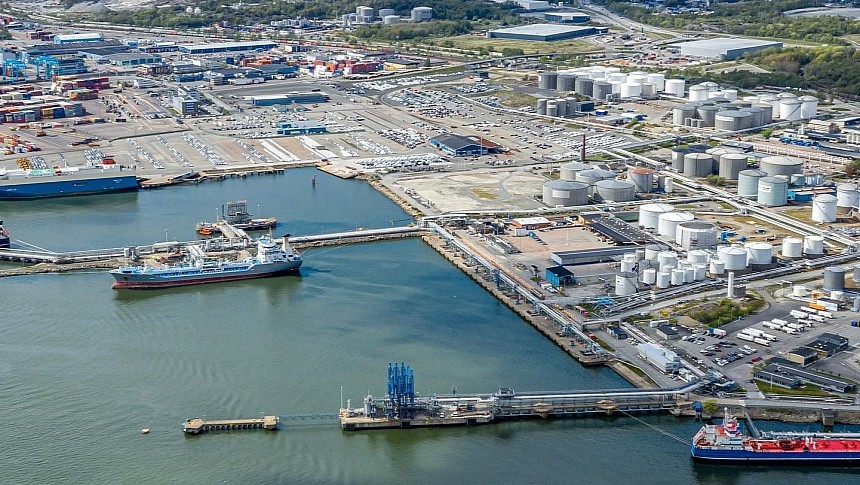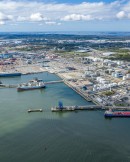Gothenburg is officially the largest port in Scandinavia, but it wants more. The Gothenburg Port Authority is on its way to becoming the greenest port in the world. It tackled this goal in various ways over the past two years. The latest change that’s about to be implemented is a digital tool that will indirectly help lower the port's overall emission levels.
Gothenburg is determined to cut CO2 emissions by a whopping 70% and to achieve this before the end of this decade. Officially named "Green Connection," this strategy involves making changes on multiple levels. The key elements are alternative fuels (with everything that's involved, including storage and easy access) and a logistics chain covering the sea, the land, and the port's terminals without relying on fossil fuels.
The Scandinavian port has committed to pumping €60 million ($65 million) into the Green Connection. Around €1.5 million ($1.6 million) was used to develop an innovative tool called Digital Port Call.
Gothenburg worked with Awake.Ai, a Finland-based company. Two years ago, they first came up with a digital tool for berth planning called Allberth. Later, this tool evolved into the more complex Digital Port Call.
The numbers look promising. With the help of the Digital Port Call, the Port Authority expects to cut 1,000 tons of CO2 emissions associated with anchored vessels each year. The reduction will be correlated to drastic time savings: 500 hours of berth time saved per year and 250 hours of anchoring time saved annually.
The key word here is efficiency. It might seem simple, but all this tool does is to organize better all the steps involved in the process of ship arrival in order to make it as efficient as possible. As a ship travels from one port to another, almost 120 different players need to work together behind the scenes to ensure a successful, smooth operation.
By digitalizing all the phases of this process, ships get to spend less time at berth, less time anchored, and even fewer days at sea. All of this results in significant fuel savings and, therefore, reduced emission levels.
Last year, the Gothenburg Port Authority also announced its plan to become the largest bunkering and storage hub for renewable methanol in Northern Europe. With more and more shipping companies opting for methanol to fuel their container ships, Gothenburg decided it wanted to support this trend with adequate infrastructure. Since then, it's been working on establishing an efficient supply chain so that it can store and supply eMethanol for ships on a regular basis.
The Scandinavian port expects to start providing eMethanol as soon as next year. That is also when it plans to officially start using the new Digital Port Call tool.
The Scandinavian port has committed to pumping €60 million ($65 million) into the Green Connection. Around €1.5 million ($1.6 million) was used to develop an innovative tool called Digital Port Call.
Gothenburg worked with Awake.Ai, a Finland-based company. Two years ago, they first came up with a digital tool for berth planning called Allberth. Later, this tool evolved into the more complex Digital Port Call.
The numbers look promising. With the help of the Digital Port Call, the Port Authority expects to cut 1,000 tons of CO2 emissions associated with anchored vessels each year. The reduction will be correlated to drastic time savings: 500 hours of berth time saved per year and 250 hours of anchoring time saved annually.
The key word here is efficiency. It might seem simple, but all this tool does is to organize better all the steps involved in the process of ship arrival in order to make it as efficient as possible. As a ship travels from one port to another, almost 120 different players need to work together behind the scenes to ensure a successful, smooth operation.
By digitalizing all the phases of this process, ships get to spend less time at berth, less time anchored, and even fewer days at sea. All of this results in significant fuel savings and, therefore, reduced emission levels.
Last year, the Gothenburg Port Authority also announced its plan to become the largest bunkering and storage hub for renewable methanol in Northern Europe. With more and more shipping companies opting for methanol to fuel their container ships, Gothenburg decided it wanted to support this trend with adequate infrastructure. Since then, it's been working on establishing an efficient supply chain so that it can store and supply eMethanol for ships on a regular basis.
The Scandinavian port expects to start providing eMethanol as soon as next year. That is also when it plans to officially start using the new Digital Port Call tool.







